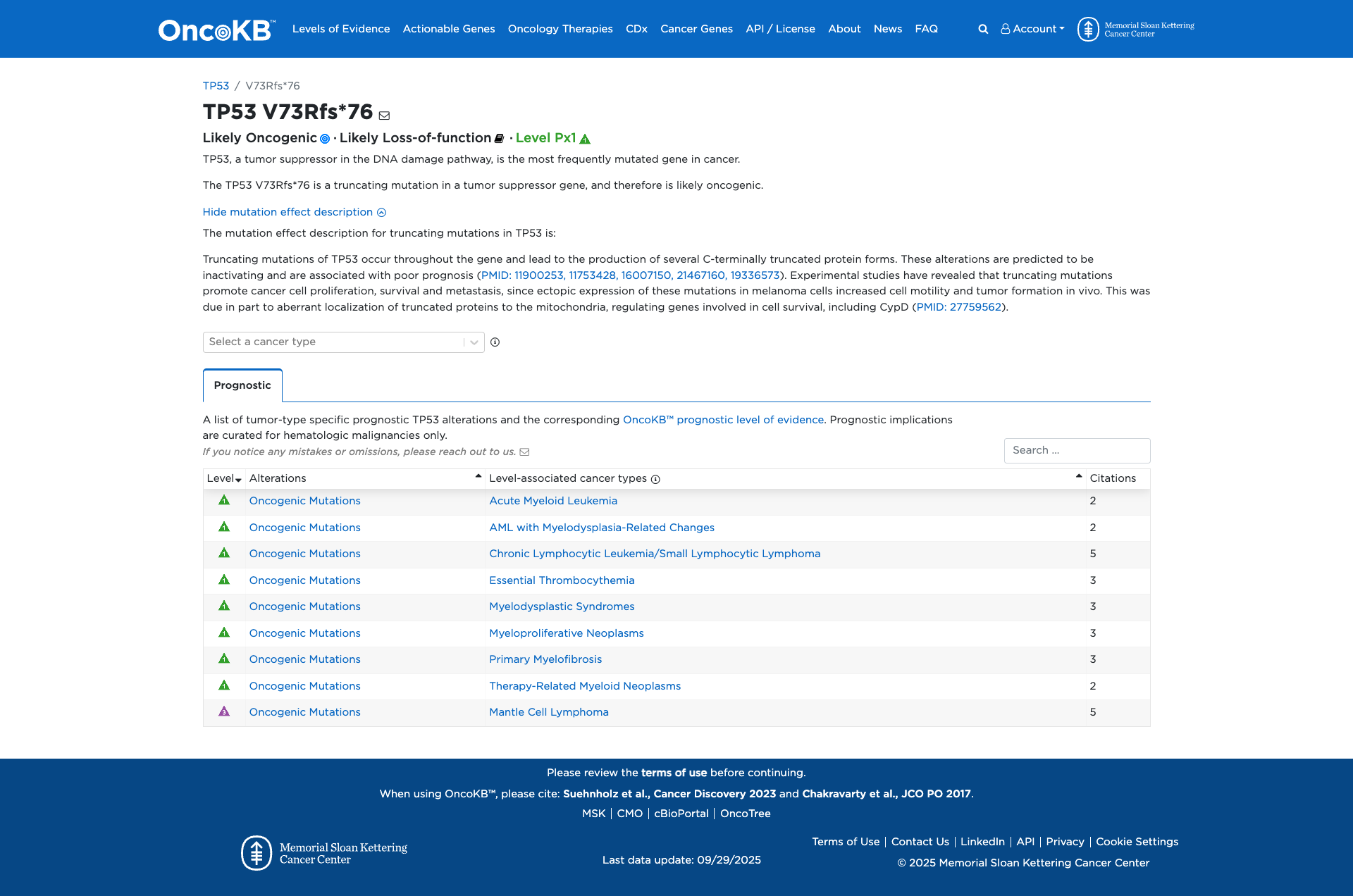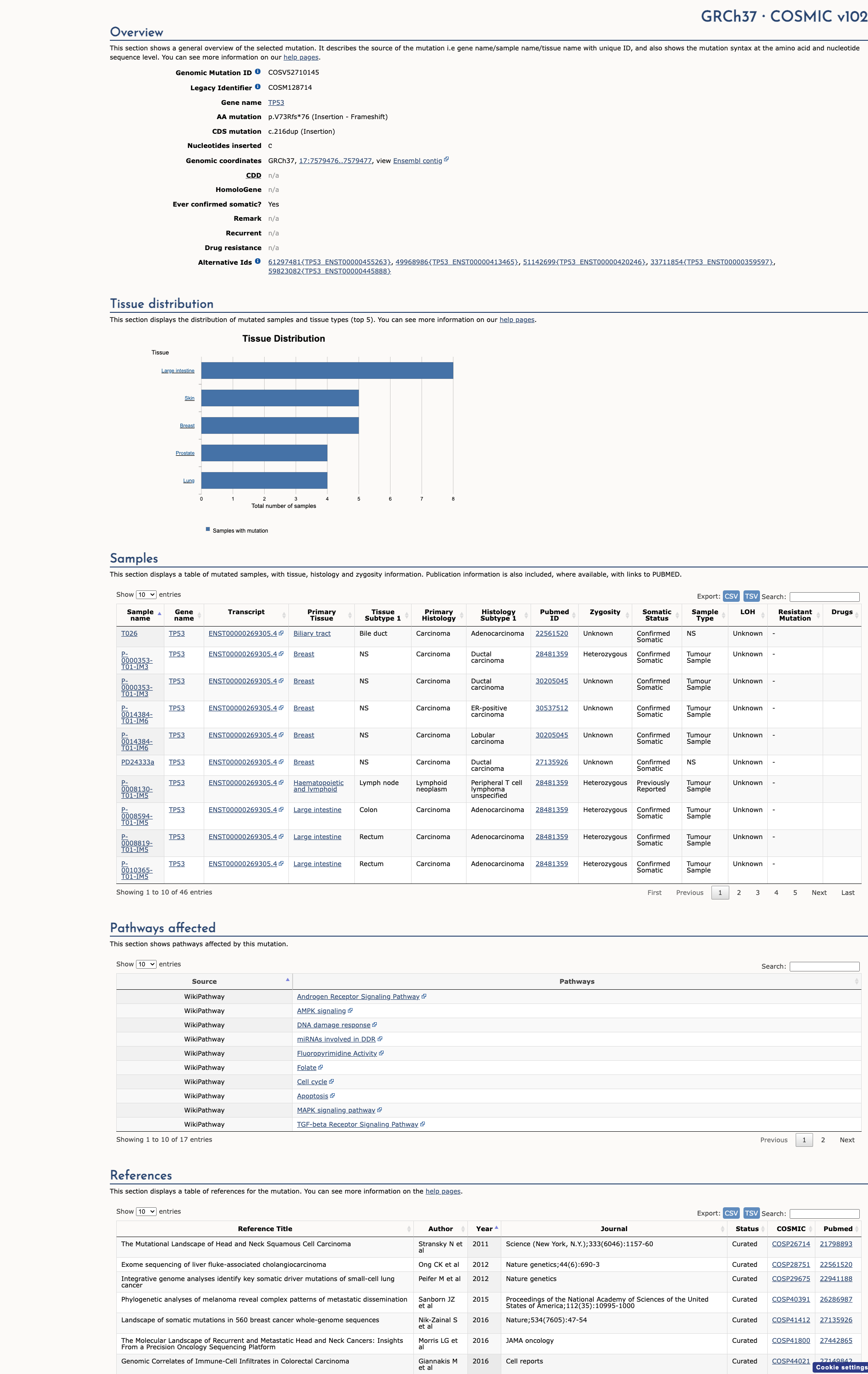TP53 c.216dup, p.Val73ArgfsTer76
NM_000546.6:c.216dup
COSMIC ID: COSM128716, COSM7449931
Pathogenic
The TP53 c.216dup (p.V73Rfs*76) variant introduces a premature stop codon and is predicted to undergo NMD (PVS1 Very Strong), is absent from population databases (PM2 Supporting), and is reported as pathogenic by multiple reputable sources (PP5 Supporting). Combined evidence supports a Pathogenic classification.
ACMG/AMP Criteria Applied
PVS1
PM2
PP5
Genetic Information
Gene & Transcript Details
Gene
TP53
Transcript
NM_000546.6
MANE Select
Total Exons
11
Strand
Reverse (−)
Reference Sequence
NC_000017.10
Alternative Transcripts
| ID | Status | Details |
|---|---|---|
| NM_000546.5 | RefSeq Select | 11 exons | Reverse |
| NM_000546.3 | Alternative | 11 exons | Reverse |
| NM_000546.4 | Alternative | 11 exons | Reverse |
| NM_000546.2 | Alternative | 11 exons | Reverse |
Variant Details
HGVS Notation
NM_000546.6:c.216dup
Protein Change
V73Rfs*76
Location
Exon 4
(Exon 4 of 11)
5'Exon Structure (11 total)3'
Functional Consequence
Loss of Function
Related Variants
No evidence of other pathogenic variants at position 73 in gene TP53
Alternate Identifiers
COSM128716, COSM7449931
Variant interpretation based on transcript NM_000546.6
Genome Browser
Loading genome browser...
HGVS InputNM_000546:c.216dup
Active Tracks
ConservationRefSeqClinVargnomAD
Navigation tips: Use mouse to drag and zoom. Click on features for details.
Clinical Data
Population Frequency
Global Frequency
0.0 in 100,000
Extremely Rare
Global: 0.0%
0%
0.05%
0.1%
1%
5%
10%+
ACMG Criteria Applied
PM2
This variant is not present in gnomAD (PM2 criteria applies).
Classification
1 publications
Likely Pathogenic
Based on 10 submitter reviews in ClinVar
Submitter Breakdown
9 Path
1 LP
Pathogenic
Likely Path.
VUS
Likely Benign
Benign
Publications (1)
This sequence change creates a premature translational stop signal (p.Val73Argfs*76) in the TP53 gene. It is expected to result in an absent or disrupted protein product. Loss-of-function variants in TP53 are known to be pathogenic (PMID: 20522432). This variant is not present in population databases (gnomAD no frequency). This premature translational stop signal has been observed in individual(s) with osteosarcoma and breast cancer (PMID: 1565143, 28369373). This variant is also known as a 1-bp insertion at codons 71-72. ClinVar contains an entry for this variant (Variation ID: 182957). For these reasons, this variant has been classified as Pathogenic.
Clinical Statement
This variant has been reported in ClinVar as Pathogenic (9 clinical laboratories) and as Likely pathogenic (1 clinical laboratories).
COSMIC ID
COSM128716, COSM7449931
Recurrence
45 occurrences
PM1 Criteria
Applied
Criterion PM1 is applied based on the high recurrence in COSMIC database.
COSMIC Database Preview
Accessing full COSMIC database details requires institutional login or subscription. External links may prompt for authentication.
Functional Impact
Functional Domain
Hotspot Status
Not a hotspot
Domain Summary
This variant is not located in a mutational hotspot or critical domain (0 mutations).
Related Variants in This Domain
No evidence of other pathogenic variants at position 73 in gene TP53
Functional Summary
The TP53 V73Rfs*76 variant is a truncating mutation in the TP53 gene, a tumor suppressor involved in the DNA damage response pathway. Functional evidence indicates that truncating mutations in TP53 lead to the production of C-terminally truncated proteins, which are predicted to be inactivating. Experimental studies have shown that these truncated proteins can promote cancer cell proliferation, survival, and metastasis, partly due to their aberrant localization to the mitochondria and regulation of cell survival genes. Therefore, the TP53 V73Rfs*76 variant is functionally characterized as likely damaging.
Database Previews
OncoKB

JAX-CKB

Click on previews to view full database entries. External databases may require institutional access.
Computational Analysis
Pathogenicity Predictions
Predictor Consensus
Unknown
PP3 Applied
No
VCEP Guidelines
Applied ACMG/AMP Criteria (VCEP Specific) VCEP Guidelines
PVS1
PVS1 (Very Strong)
According to VCEP guidelines, "Nonsense or frameshift variants: PVS1 applies to variants predicted to result in nonsense-mediated decay (NMD) for frameshift induced premature termination codon (PTC) upstream of p.Lys351". The evidence for this variant shows that c.216dup (p.V73Rfs*76) introduces a PTC at codon 76, well upstream of p.Lys351, predicting NMD. Therefore, this criterion is applied at Very Strong strength because the frameshift is upstream of the NMD boundary.
PS1
PS1 (Not Applied) Strength Modified
According to VCEP guidelines, PS1 applies only to variants asserted as Pathogenic with the same amino acid change via a different nucleotide. The evidence for this variant shows it is a frameshift, not a missense with a known AA substitution. Therefore, PS1 is not applied.
PS2
PS2 (Not Applied) Strength Modified
According to VCEP guidelines, PS2 applies for confirmed de novo variants with parental testing. No de novo or parental data are provided for this variant. Therefore, PS2 is not applied.
PS3
PS3 (Not Applied) Strength Modified
According to VCEP guidelines, "PS3 should not be applied at any strength if PVS1 is applied at full strength." PVS1 is applied at Very Strong, so PS3 is not applied.
PS4
PS4 (Not Applied) Strength Modified
According to VCEP guidelines, PS4 requires proband point totals from case data. No case counts or proband points are provided. Therefore, PS4 is not applied.
PM1
PM1 (Not Applied) Strength Modified
According to VCEP guidelines, PM1 applies to missense variants at established hotspots. This variant is a frameshift, not a missense, so PM1 is not applied.
PM2
PM2 (Supporting) Strength Modified
According to VCEP guidelines, "Variant should have an allele frequency of less than 0.00003 (0.003%) in gnomAD" to apply PM2 at Supporting level. The evidence for this variant shows it is absent from gnomAD (MAF = 0%). Therefore, PM2 is applied at Supporting strength.
PM3
PM3 (Not Applied) Strength Modified
According to standard ACMG guidelines, PM3 applies to recessive disorder variants observed in trans with a pathogenic variant. No trans or recessive inheritance data are provided. Therefore, PM3 is not applied.
PM4
PM4 (Not Applied) Strength Modified
According to standard ACMG guidelines, PM4 applies to protein length changes due to in-frame indels or stop-loss variants. This variant is a frameshift causing NMD (covered by PVS1), so PM4 is not applied.
PM5
PM5 (Not Applied) Strength Modified
According to VCEP guidelines, PM5 applies to missense variants at residues with prior pathogenic missense changes. This variant is a frameshift, not missense, so PM5 is not applied.
PM6
PM6 (Not Applied) Strength Modified
According to standard ACMG guidelines, PM6 applies to assumed de novo variants without parental confirmation. No de novo data are available. Therefore, PM6 is not applied.
PP1
PP1 (Not Applied) Strength Modified
According to VCEP guidelines, PP1 applies for cosegregation in families. No segregation data are provided. Therefore, PP1 is not applied.
PP2
PP2 (Not Applied) Strength Modified
According to standard ACMG guidelines, PP2 applies to missense variants in genes with low benign missense variation. This frameshift variant is not missense; PP2 is not applied.
PP3
PP3 (Not Applied) Strength Modified
According to standard ACMG guidelines, PP3 applies to computational evidence for missense or splicing impact. This frameshift variant leads to NMD; in silico splicing tools show minimal impact but PP3 is not appropriate for NMD variants. Therefore, PP3 is not applied.
PP4
PP4 (Not Applied) Strength Modified
According to standard ACMG guidelines, PP4 applies when the phenotype is highly specific for a single gene disorder. No phenotype data are provided. Therefore, PP4 is not applied.
PP5
PP5 (Supporting)
According to standard ACMG guidelines, PP5 applies when a reputable source reports a variant as pathogenic without available evidence. ClinVar lists this variant as Pathogenic by nine clinical laboratories and Likely Pathogenic by one. Therefore, PP5 is applied at Supporting strength.
BA1
BA1 (Not Applied) Strength Modified
According to VCEP guidelines, BA1 requires an allele frequency ≥0.001. This variant is absent from population databases (MAF = 0%), so BA1 is not applied.
BS1
BS1 (Not Applied) Strength Modified
According to VCEP guidelines, BS1 applies for allele frequency ≥0.0003 but <0.001. This variant is absent (MAF = 0%), so BS1 is not applied.
BS2
BS2 (Not Applied) Strength Modified
According to VCEP guidelines, BS2 applies when ≥2 unaffected older individuals are observed. No such data are provided. Therefore, BS2 is not applied.
BS3
BS3 (Not Applied) Strength Modified
According to VCEP guidelines, BS3 applies when functional assays demonstrate no loss of function. Here, functional evidence indicates loss of function, so BS3 is not applied.
BS4
BS4 (Not Applied) Strength Modified
According to VCEP guidelines, BS4 applies for lack of segregation in affected family members. No segregation data are available. Therefore, BS4 is not applied.
BP1
BP1 (Not Applied) Strength Modified
According to standard ACMG guidelines, BP1 applies to missense variants in a gene where only truncating variants cause disease. This is a truncating variant; BP1 is not applicable.
BP2
BP2 (Not Applied) Strength Modified
According to standard ACMG guidelines, BP2 applies when observed in trans with a pathogenic variant or in cis with another. No such data are available. Therefore, BP2 is not applied.
BP3
BP3 (Not Applied) Strength Modified
According to standard ACMG guidelines, BP3 applies to in-frame indels in repetitive regions without functional impact. This variant is a frameshift causing NMD, so BP3 is not applied.
BP4
BP4 (Not Applied) Strength Modified
According to VCEP guidelines, BP4 applies to benign computational evidence for missense/splicing. This frameshift variant leads to NMD; BP4 is not applicable.
BP5
BP5 (Not Applied) Strength Modified
According to standard ACMG guidelines, BP5 applies when a variant is found in a case with an alternate molecular basis for disease. No such data are provided. Therefore, BP5 is not applied.
BP6
BP6 (Not Applied) Strength Modified
According to standard ACMG guidelines, BP6 applies when a reputable source reports a variant as benign. No such report exists. Therefore, BP6 is not applied.
BP7
BP7 (Not Applied) Strength Modified
According to VCEP guidelines, BP7 applies to synonymous or intronic variants with no splicing impact. This variant is not synonymous or intronic. Therefore, BP7 is not applied.

